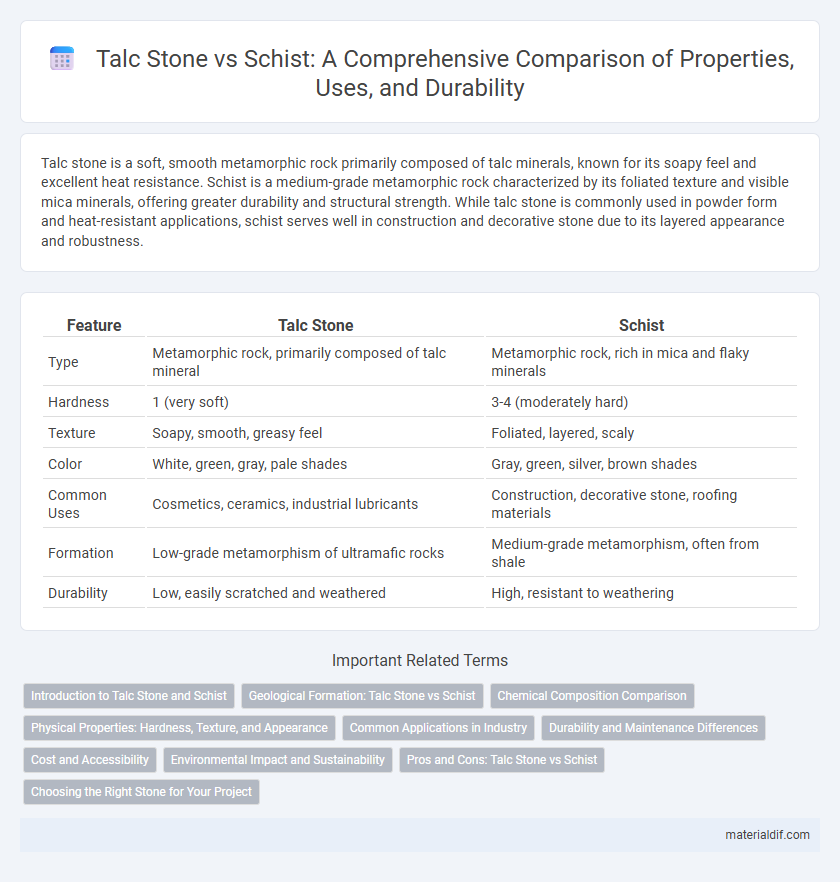Talc stone is a soft, smooth metamorphic rock primarily composed of talc minerals, known for its soapy feel and excellent heat resistance. Schist is a medium-grade metamorphic rock characterized by its foliated texture and visible mica minerals, offering greater durability and structural strength. While talc stone is commonly used in powder form and heat-resistant applications, schist serves well in construction and decorative stone due to its layered appearance and robustness.
Table of Comparison
| Feature | Talc Stone | Schist |
|---|---|---|
| Type | Metamorphic rock, primarily composed of talc mineral | Metamorphic rock, rich in mica and flaky minerals |
| Hardness | 1 (very soft) | 3-4 (moderately hard) |
| Texture | Soapy, smooth, greasy feel | Foliated, layered, scaly |
| Color | White, green, gray, pale shades | Gray, green, silver, brown shades |
| Common Uses | Cosmetics, ceramics, industrial lubricants | Construction, decorative stone, roofing materials |
| Formation | Low-grade metamorphism of ultramafic rocks | Medium-grade metamorphism, often from shale |
| Durability | Low, easily scratched and weathered | High, resistant to weathering |
Introduction to Talc Stone and Schist
Talc stone, known for its softness and magnesium-rich composition, is primarily used in industrial applications such as cosmetics and ceramics due to its excellent lubricating properties. Schist, a medium-grade metamorphic rock, exhibits pronounced foliation with visible mineral grains like mica and quartz, making it valuable in construction and decorative stone projects. Understanding the mineralogy and texture differences between talc stone and schist is crucial for selecting the appropriate material in geological and commercial contexts.
Geological Formation: Talc Stone vs Schist
Talc stone is primarily formed through hydrothermal alteration of ultramafic rocks, resulting in a soft, foliated mineral rich in magnesium silicate. Schist originates from medium to high-grade metamorphism of sedimentary or igneous rocks, characterized by pronounced foliation due to mica and other platy minerals. The distinct geological formation processes of talc stone and schist influence their mineral composition, texture, and industrial applications.
Chemical Composition Comparison
Talc stone primarily consists of talc mineral with the chemical formula Mg3Si4O10(OH)2, characterized by high magnesium and silica content along with hydroxyl groups. Schist, a metamorphic rock, contains a more varied chemical composition including quartz, mica, and feldspar, with significant amounts of aluminum, potassium, sodium, and iron oxides in addition to silica. The fundamental difference lies in talc's magnesium silicate structure versus schist's heterogeneous mineral assemblage resulting from regional metamorphism.
Physical Properties: Hardness, Texture, and Appearance
Talc stone exhibits a very low hardness of 1 on the Mohs scale, characterized by a smooth, soapy texture and a pale green to white coloration. Schist, contrastingly, has a higher hardness around 3 to 4, featuring a foliated texture with visible mineral grains and a shiny, layered appearance. The softness and greasy feel of talc make it distinct from the coarse, crystalline, and shiny surface typical of schist.
Common Applications in Industry
Talc stone is widely used in the cosmetics, paint, and paper industries due to its softness and excellent moisture absorption properties, making it ideal for talcum powder and filler materials. Schist, with its foliated texture and durability, is commonly utilized in construction and landscaping for decorative stone, roofing, and paving applications. The distinct physical and chemical properties of talc and schist define their specialized industrial uses, with talc emphasizing softness and chemical inertness, while schist provides strength and aesthetic appeal.
Durability and Maintenance Differences
Talc stone, known for its softness and low hardness rating of 1 on the Mohs scale, is less durable and more prone to scratching and abrasion compared to schist, which rates around 3 to 4 and offers greater strength and resistance. Schist displays higher durability due to its foliated texture and mineral composition, making it more suitable for flooring and exterior applications that require longevity. Maintenance of talc stone involves careful sealing and gentle cleaning to prevent damage, while schist's robust nature reduces the frequency of upkeep and allows for more aggressive cleaning methods.
Cost and Accessibility
Talc stone is generally more affordable and widely accessible due to its abundant natural deposits and ease of mining, making it a cost-effective option for various industrial applications. In contrast, schist, characterized by its foliated texture and variable mineral composition, tends to be more expensive and less accessible because it is often sourced from specific geological formations requiring specialized extraction methods. The cost difference between talc and schist is primarily influenced by their availability, processing complexity, and market demand within construction and manufacturing sectors.
Environmental Impact and Sustainability
Talc stone mining often results in significant environmental degradation due to the release of hazardous dust particles, negatively affecting air quality and local ecosystems. Schist extraction generally has a lower environmental footprint since it requires less intensive processing and energy consumption, promoting greater sustainability. Incorporating responsible mining practices and rehabilitation efforts can mitigate the ecological impact of both talc and schist stone extraction.
Pros and Cons: Talc Stone vs Schist
Talc stone offers exceptional softness and a smooth, soapy texture, making it ideal for carving and decorative applications; however, it lacks durability and is prone to scratching and abrasion. Schist provides greater hardness and durability with its foliated structure, suitable for construction and landscaping, but it can be more difficult to shape and may fracture along its layered planes. Choosing between talc stone and schist depends on balancing the need for workability against structural strength and resistance to wear.
Choosing the Right Stone for Your Project
Talc stone offers exceptional softness and heat resistance, making it ideal for applications requiring smooth surfaces and thermal insulation. Schist, with its foliated texture and higher durability, is better suited for structural uses and outdoor environments demanding weather resistance. Selecting the right stone depends on project requirements like hardness, aesthetic appeal, and environmental exposure.
Talc Stone vs Schist Infographic

 materialdif.com
materialdif.com